A Narrative Review of Obesity Prevalence and Risk Factors in Adults
VerifiedAdded on 2023/06/09
|31
|4973
|218
Literature Review
AI Summary
This narrative review investigates the prevalence and risk factors of obesity in ethnic Indian adults aged 40-70. It highlights the increasing rates of obesity in India, particularly among Indo-Aryans, and explores factors such as unhealthy diets, lack of physical activity, and genetic predispositions. The review analyzes existing literature to identify gaps in awareness and intervention strategies, aiming to provide evidence for effective mitigation of obesity in this population. The methodology involves searching electronic databases like PubMed and Google Scholar for relevant studies, followed by thematic analysis to identify key risk factors and potential interventions. Ultimately, the review seeks to inform public health initiatives and promote well-being by addressing the growing obesity epidemic in ethnic Indian communities. Desklib offers a range of solved assignments and study resources for students.
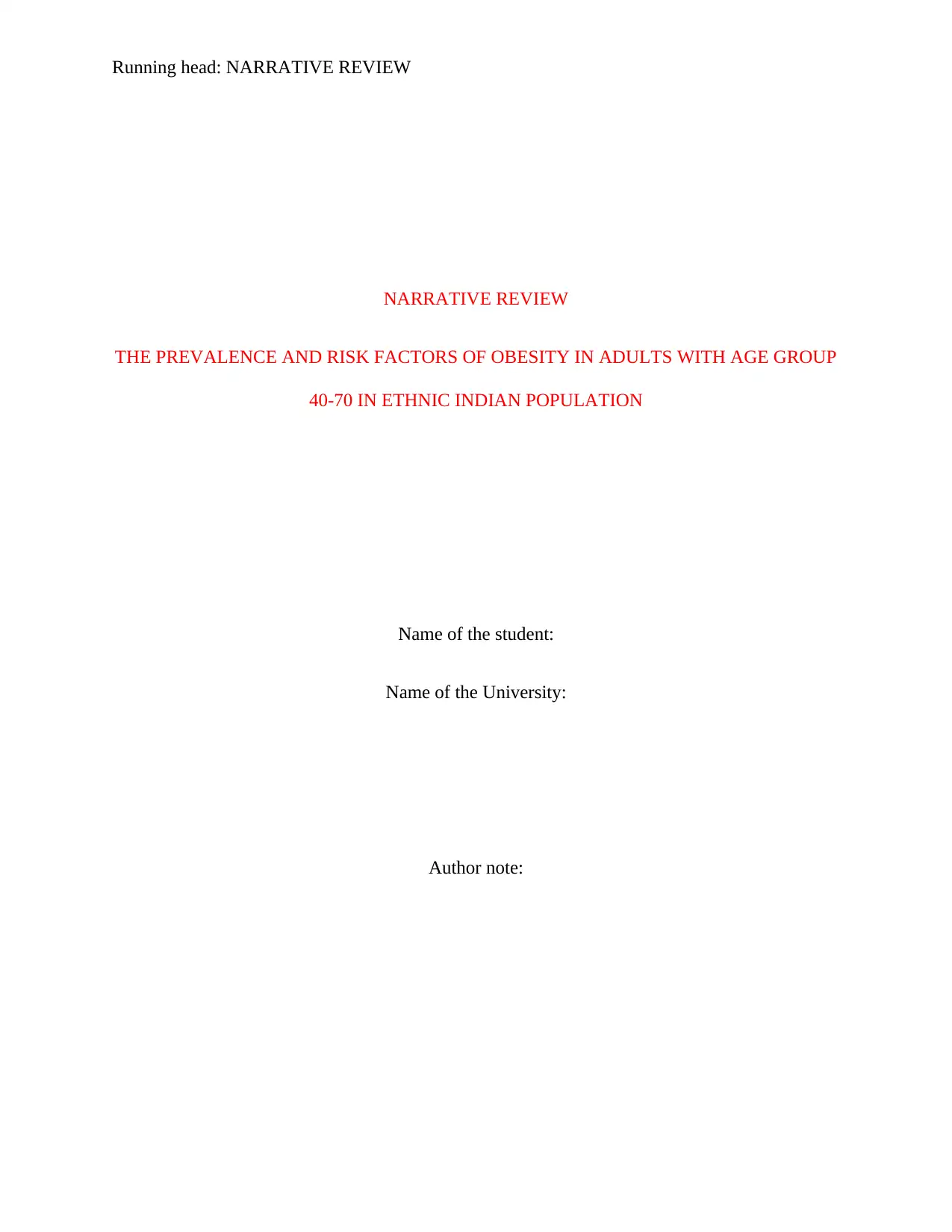
Running head: NARRATIVE REVIEW
NARRATIVE REVIEW
THE PREVALENCE AND RISK FACTORS OF OBESITY IN ADULTS WITH AGE GROUP
40-70 IN ETHNIC INDIAN POPULATION
Name of the student:
Name of the University:
Author note:
NARRATIVE REVIEW
THE PREVALENCE AND RISK FACTORS OF OBESITY IN ADULTS WITH AGE GROUP
40-70 IN ETHNIC INDIAN POPULATION
Name of the student:
Name of the University:
Author note:
Paraphrase This Document
Need a fresh take? Get an instant paraphrase of this document with our AI Paraphraser

1NARRATIVE REVIEW
1. Introduction:
Obesity is considered as the health condition in which body accumulates excess fat in a
high rate that could affect the health condition of individual, thus could reduce the expectancy of
life and increase enormous health issues. In Western countries obesity is defined as a condition
when BMI is measured by dividing the weight of a person by the square of the height of the
person and the result exceeds 30 kg/m2. The BMI range from 25-30 kg/m2 is considered as
overweight (1). The paper will focus on the prevalence and risk factors of obesity in India as
obesity has reached the epidemic level in the country.
1.1 Background:
Like the other countries in the world obesity has become a threat for the health care
system in the ethnic Indian population (2). The major ethnic Indians include Indo-Aryan,
Dravidian and Mongoloid. There are 72% population in India that are Indo-Aryan, 25% are
Dravidian and 3% are Mongoloid. Indo Aryans are mainly located in the central north part of
India, Mongoloids are resided in the borders of India with Nepal and China and Dravidians are
located in the south part of India. Research has been found that obesity has reached to the
epidemic level in the ethnic Indian population in the 21st century and Indo-Aryan population is
more vulnerable to obesity (3). The rate of morbid obesity in the population is 5%. Unhealthy
and poorly processed food has become highly accessible in the country and India has integrated
continuously in the global food markets (4). Such situation has lead to the increase in the average
calorie intake in individual. According to the research obesity is one of the major causes of
severe disease such as cardiovascular risk and cancer (5). Thus, it has created pressure in the
health workforce. According to a study the rate of obesity has been increased in last 10 years. In
1. Introduction:
Obesity is considered as the health condition in which body accumulates excess fat in a
high rate that could affect the health condition of individual, thus could reduce the expectancy of
life and increase enormous health issues. In Western countries obesity is defined as a condition
when BMI is measured by dividing the weight of a person by the square of the height of the
person and the result exceeds 30 kg/m2. The BMI range from 25-30 kg/m2 is considered as
overweight (1). The paper will focus on the prevalence and risk factors of obesity in India as
obesity has reached the epidemic level in the country.
1.1 Background:
Like the other countries in the world obesity has become a threat for the health care
system in the ethnic Indian population (2). The major ethnic Indians include Indo-Aryan,
Dravidian and Mongoloid. There are 72% population in India that are Indo-Aryan, 25% are
Dravidian and 3% are Mongoloid. Indo Aryans are mainly located in the central north part of
India, Mongoloids are resided in the borders of India with Nepal and China and Dravidians are
located in the south part of India. Research has been found that obesity has reached to the
epidemic level in the ethnic Indian population in the 21st century and Indo-Aryan population is
more vulnerable to obesity (3). The rate of morbid obesity in the population is 5%. Unhealthy
and poorly processed food has become highly accessible in the country and India has integrated
continuously in the global food markets (4). Such situation has lead to the increase in the average
calorie intake in individual. According to the research obesity is one of the major causes of
severe disease such as cardiovascular risk and cancer (5). Thus, it has created pressure in the
health workforce. According to a study the rate of obesity has been increased in last 10 years. In
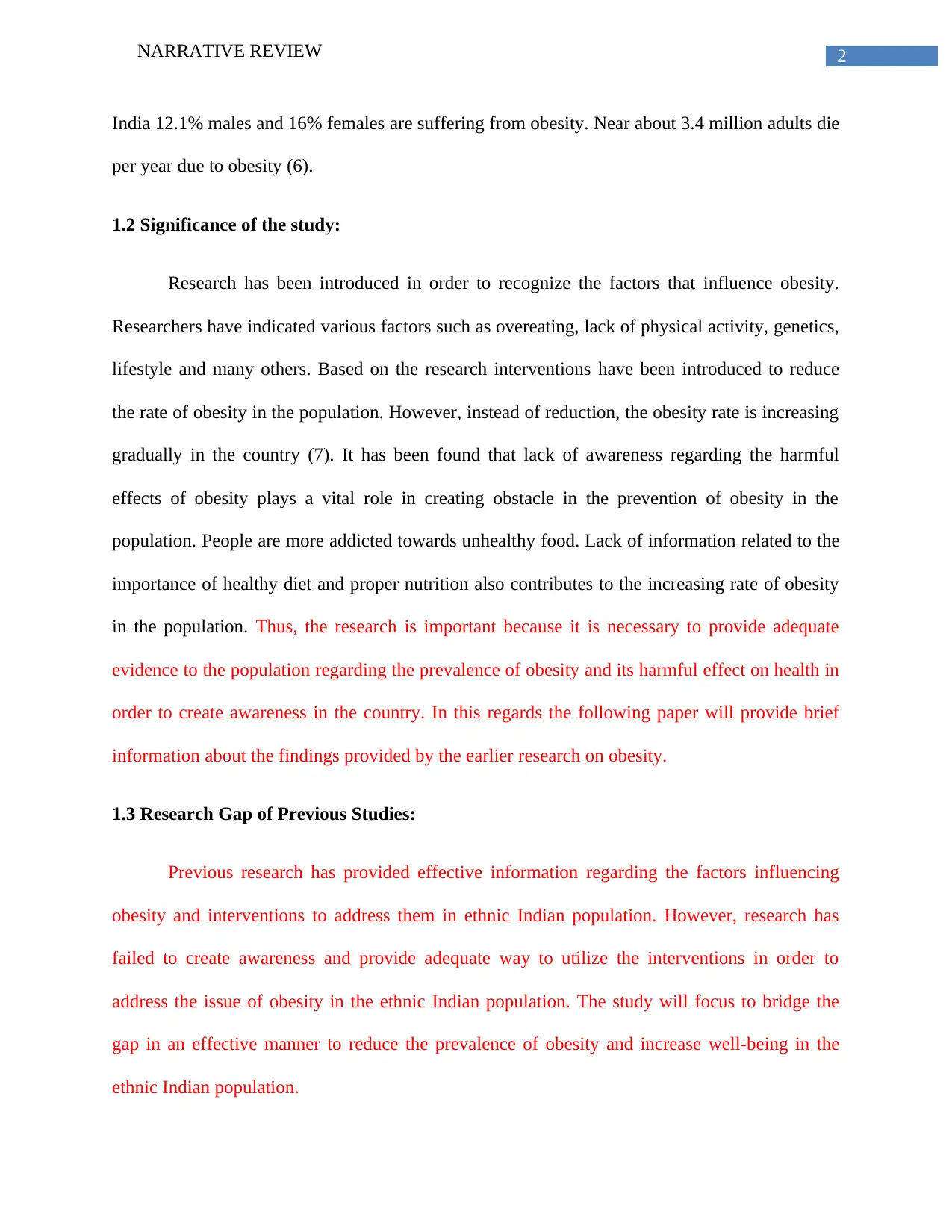
2NARRATIVE REVIEW
India 12.1% males and 16% females are suffering from obesity. Near about 3.4 million adults die
per year due to obesity (6).
1.2 Significance of the study:
Research has been introduced in order to recognize the factors that influence obesity.
Researchers have indicated various factors such as overeating, lack of physical activity, genetics,
lifestyle and many others. Based on the research interventions have been introduced to reduce
the rate of obesity in the population. However, instead of reduction, the obesity rate is increasing
gradually in the country (7). It has been found that lack of awareness regarding the harmful
effects of obesity plays a vital role in creating obstacle in the prevention of obesity in the
population. People are more addicted towards unhealthy food. Lack of information related to the
importance of healthy diet and proper nutrition also contributes to the increasing rate of obesity
in the population. Thus, the research is important because it is necessary to provide adequate
evidence to the population regarding the prevalence of obesity and its harmful effect on health in
order to create awareness in the country. In this regards the following paper will provide brief
information about the findings provided by the earlier research on obesity.
1.3 Research Gap of Previous Studies:
Previous research has provided effective information regarding the factors influencing
obesity and interventions to address them in ethnic Indian population. However, research has
failed to create awareness and provide adequate way to utilize the interventions in order to
address the issue of obesity in the ethnic Indian population. The study will focus to bridge the
gap in an effective manner to reduce the prevalence of obesity and increase well-being in the
ethnic Indian population.
India 12.1% males and 16% females are suffering from obesity. Near about 3.4 million adults die
per year due to obesity (6).
1.2 Significance of the study:
Research has been introduced in order to recognize the factors that influence obesity.
Researchers have indicated various factors such as overeating, lack of physical activity, genetics,
lifestyle and many others. Based on the research interventions have been introduced to reduce
the rate of obesity in the population. However, instead of reduction, the obesity rate is increasing
gradually in the country (7). It has been found that lack of awareness regarding the harmful
effects of obesity plays a vital role in creating obstacle in the prevention of obesity in the
population. People are more addicted towards unhealthy food. Lack of information related to the
importance of healthy diet and proper nutrition also contributes to the increasing rate of obesity
in the population. Thus, the research is important because it is necessary to provide adequate
evidence to the population regarding the prevalence of obesity and its harmful effect on health in
order to create awareness in the country. In this regards the following paper will provide brief
information about the findings provided by the earlier research on obesity.
1.3 Research Gap of Previous Studies:
Previous research has provided effective information regarding the factors influencing
obesity and interventions to address them in ethnic Indian population. However, research has
failed to create awareness and provide adequate way to utilize the interventions in order to
address the issue of obesity in the ethnic Indian population. The study will focus to bridge the
gap in an effective manner to reduce the prevalence of obesity and increase well-being in the
ethnic Indian population.
⊘ This is a preview!⊘
Do you want full access?
Subscribe today to unlock all pages.

Trusted by 1+ million students worldwide
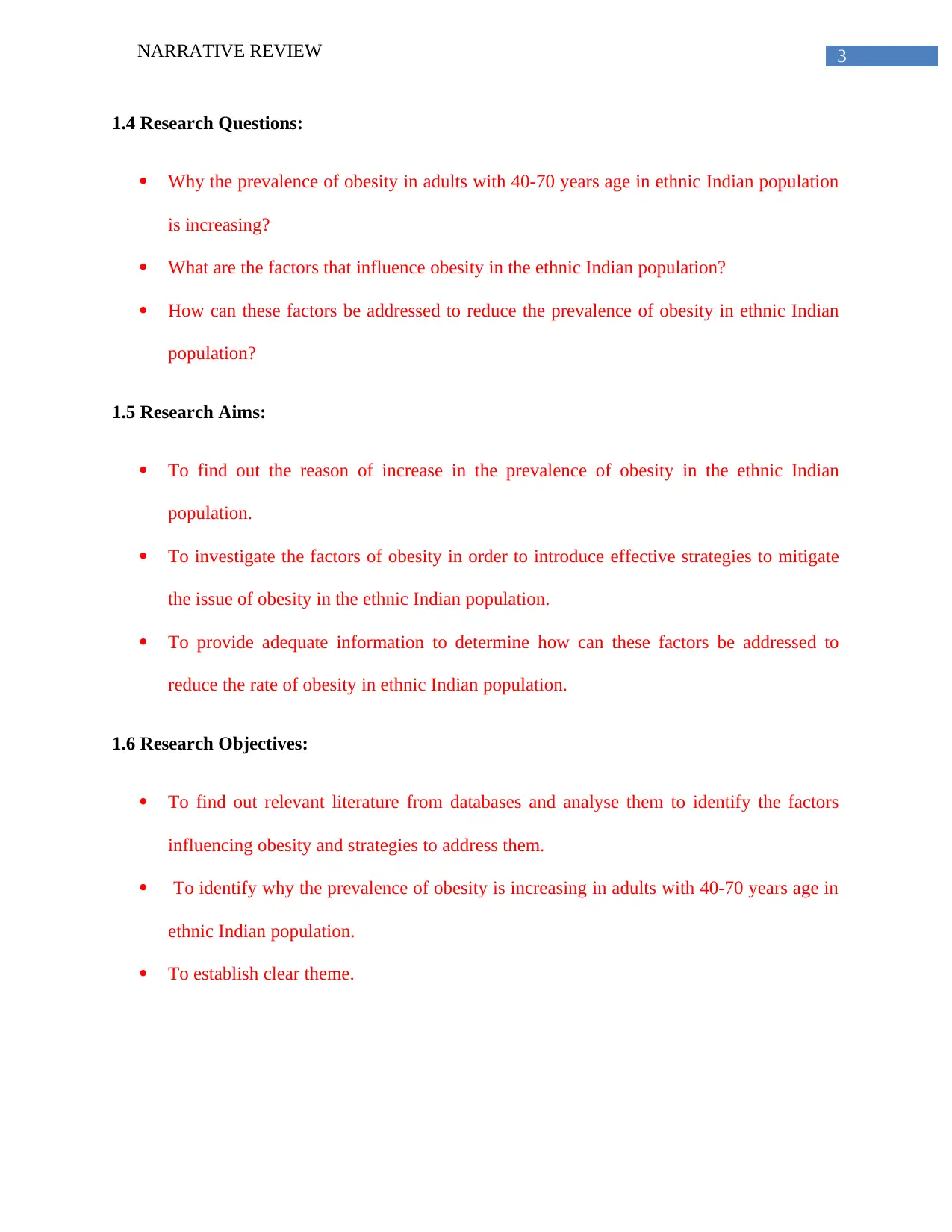
3NARRATIVE REVIEW
1.4 Research Questions:
Why the prevalence of obesity in adults with 40-70 years age in ethnic Indian population
is increasing?
What are the factors that influence obesity in the ethnic Indian population?
How can these factors be addressed to reduce the prevalence of obesity in ethnic Indian
population?
1.5 Research Aims:
To find out the reason of increase in the prevalence of obesity in the ethnic Indian
population.
To investigate the factors of obesity in order to introduce effective strategies to mitigate
the issue of obesity in the ethnic Indian population.
To provide adequate information to determine how can these factors be addressed to
reduce the rate of obesity in ethnic Indian population.
1.6 Research Objectives:
To find out relevant literature from databases and analyse them to identify the factors
influencing obesity and strategies to address them.
To identify why the prevalence of obesity is increasing in adults with 40-70 years age in
ethnic Indian population.
To establish clear theme.
1.4 Research Questions:
Why the prevalence of obesity in adults with 40-70 years age in ethnic Indian population
is increasing?
What are the factors that influence obesity in the ethnic Indian population?
How can these factors be addressed to reduce the prevalence of obesity in ethnic Indian
population?
1.5 Research Aims:
To find out the reason of increase in the prevalence of obesity in the ethnic Indian
population.
To investigate the factors of obesity in order to introduce effective strategies to mitigate
the issue of obesity in the ethnic Indian population.
To provide adequate information to determine how can these factors be addressed to
reduce the rate of obesity in ethnic Indian population.
1.6 Research Objectives:
To find out relevant literature from databases and analyse them to identify the factors
influencing obesity and strategies to address them.
To identify why the prevalence of obesity is increasing in adults with 40-70 years age in
ethnic Indian population.
To establish clear theme.
Paraphrase This Document
Need a fresh take? Get an instant paraphrase of this document with our AI Paraphraser
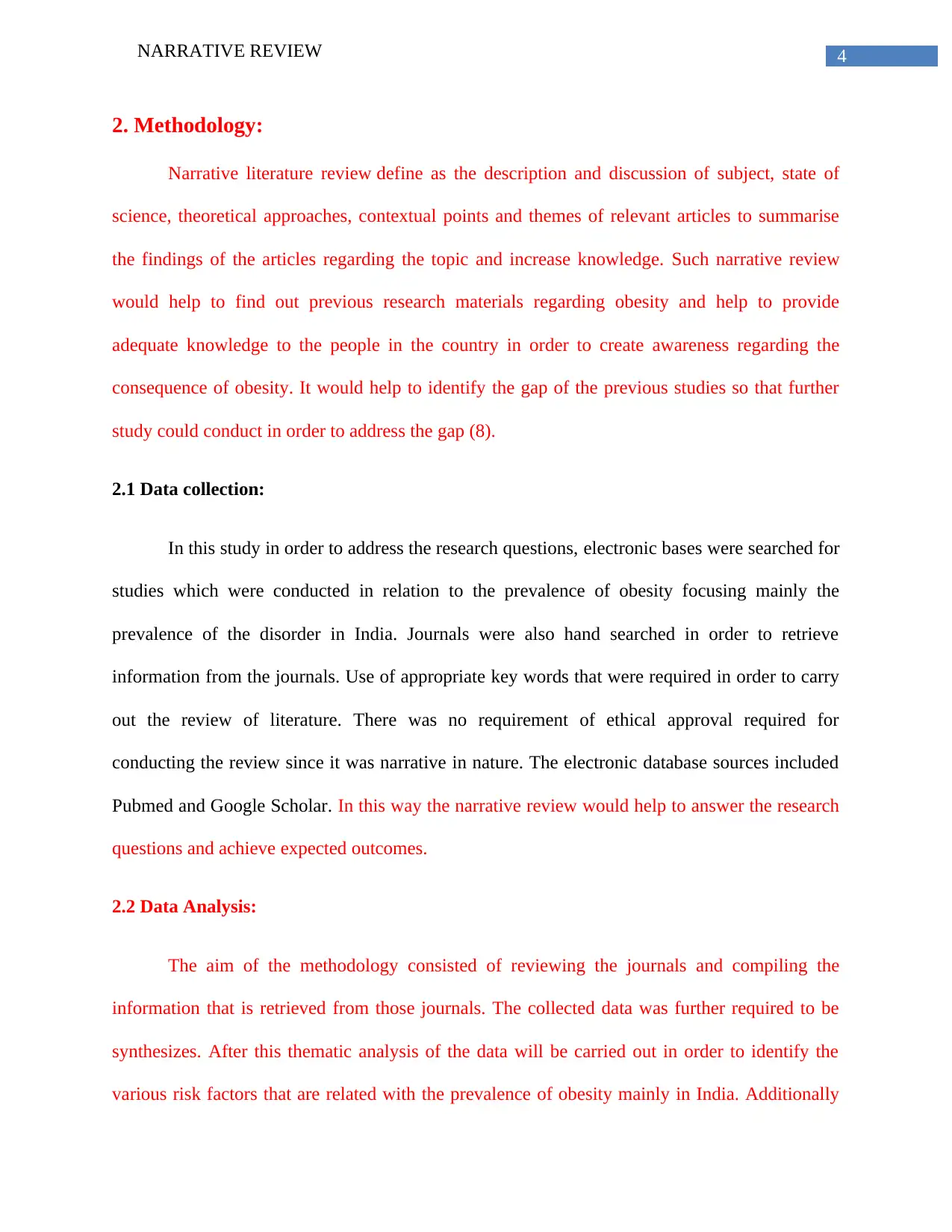
4NARRATIVE REVIEW
2. Methodology:
Narrative literature review define as the description and discussion of subject, state of
science, theoretical approaches, contextual points and themes of relevant articles to summarise
the findings of the articles regarding the topic and increase knowledge. Such narrative review
would help to find out previous research materials regarding obesity and help to provide
adequate knowledge to the people in the country in order to create awareness regarding the
consequence of obesity. It would help to identify the gap of the previous studies so that further
study could conduct in order to address the gap (8).
2.1 Data collection:
In this study in order to address the research questions, electronic bases were searched for
studies which were conducted in relation to the prevalence of obesity focusing mainly the
prevalence of the disorder in India. Journals were also hand searched in order to retrieve
information from the journals. Use of appropriate key words that were required in order to carry
out the review of literature. There was no requirement of ethical approval required for
conducting the review since it was narrative in nature. The electronic database sources included
Pubmed and Google Scholar. In this way the narrative review would help to answer the research
questions and achieve expected outcomes.
2.2 Data Analysis:
The aim of the methodology consisted of reviewing the journals and compiling the
information that is retrieved from those journals. The collected data was further required to be
synthesizes. After this thematic analysis of the data will be carried out in order to identify the
various risk factors that are related with the prevalence of obesity mainly in India. Additionally
2. Methodology:
Narrative literature review define as the description and discussion of subject, state of
science, theoretical approaches, contextual points and themes of relevant articles to summarise
the findings of the articles regarding the topic and increase knowledge. Such narrative review
would help to find out previous research materials regarding obesity and help to provide
adequate knowledge to the people in the country in order to create awareness regarding the
consequence of obesity. It would help to identify the gap of the previous studies so that further
study could conduct in order to address the gap (8).
2.1 Data collection:
In this study in order to address the research questions, electronic bases were searched for
studies which were conducted in relation to the prevalence of obesity focusing mainly the
prevalence of the disorder in India. Journals were also hand searched in order to retrieve
information from the journals. Use of appropriate key words that were required in order to carry
out the review of literature. There was no requirement of ethical approval required for
conducting the review since it was narrative in nature. The electronic database sources included
Pubmed and Google Scholar. In this way the narrative review would help to answer the research
questions and achieve expected outcomes.
2.2 Data Analysis:
The aim of the methodology consisted of reviewing the journals and compiling the
information that is retrieved from those journals. The collected data was further required to be
synthesizes. After this thematic analysis of the data will be carried out in order to identify the
various risk factors that are related with the prevalence of obesity mainly in India. Additionally
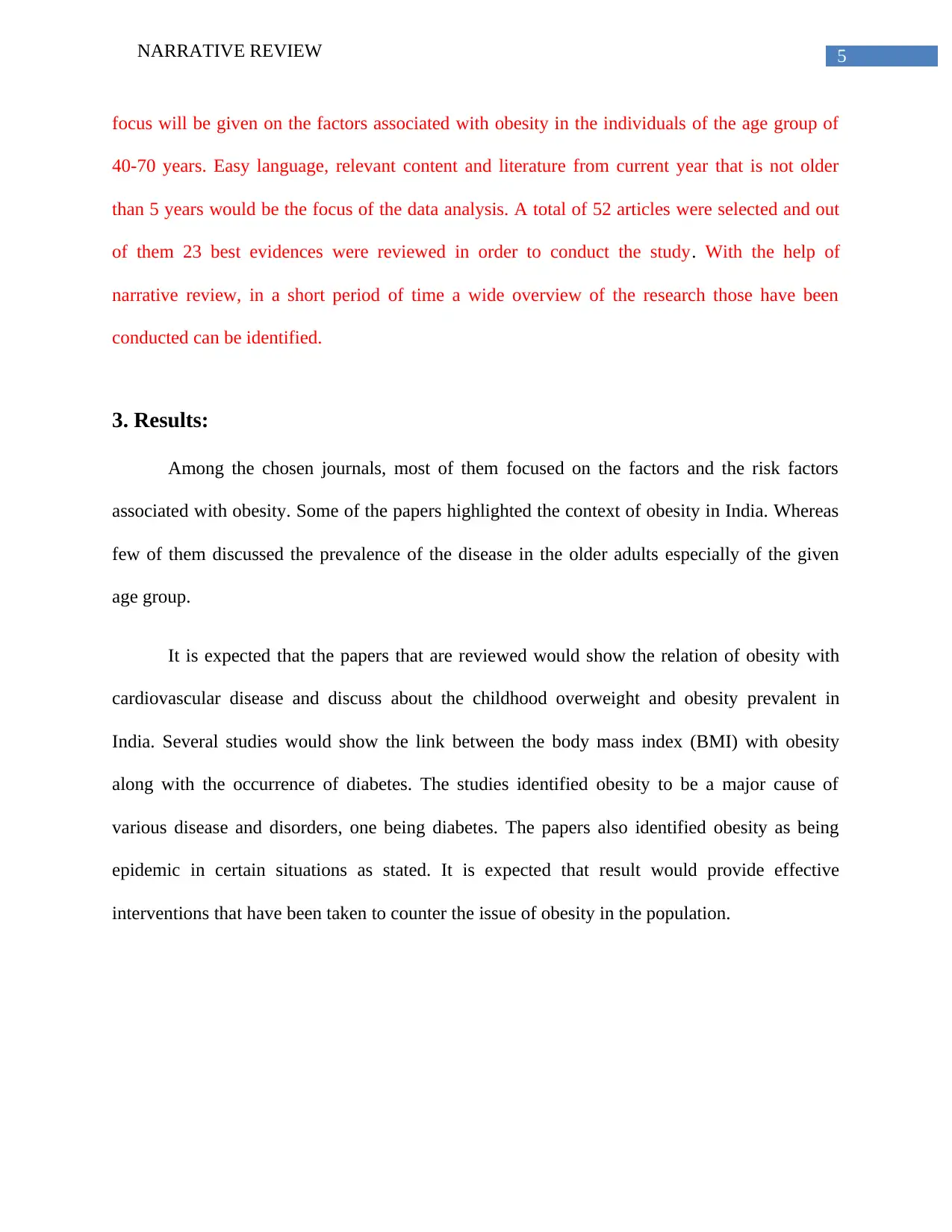
5NARRATIVE REVIEW
focus will be given on the factors associated with obesity in the individuals of the age group of
40-70 years. Easy language, relevant content and literature from current year that is not older
than 5 years would be the focus of the data analysis. A total of 52 articles were selected and out
of them 23 best evidences were reviewed in order to conduct the study. With the help of
narrative review, in a short period of time a wide overview of the research those have been
conducted can be identified.
3. Results:
Among the chosen journals, most of them focused on the factors and the risk factors
associated with obesity. Some of the papers highlighted the context of obesity in India. Whereas
few of them discussed the prevalence of the disease in the older adults especially of the given
age group.
It is expected that the papers that are reviewed would show the relation of obesity with
cardiovascular disease and discuss about the childhood overweight and obesity prevalent in
India. Several studies would show the link between the body mass index (BMI) with obesity
along with the occurrence of diabetes. The studies identified obesity to be a major cause of
various disease and disorders, one being diabetes. The papers also identified obesity as being
epidemic in certain situations as stated. It is expected that result would provide effective
interventions that have been taken to counter the issue of obesity in the population.
focus will be given on the factors associated with obesity in the individuals of the age group of
40-70 years. Easy language, relevant content and literature from current year that is not older
than 5 years would be the focus of the data analysis. A total of 52 articles were selected and out
of them 23 best evidences were reviewed in order to conduct the study. With the help of
narrative review, in a short period of time a wide overview of the research those have been
conducted can be identified.
3. Results:
Among the chosen journals, most of them focused on the factors and the risk factors
associated with obesity. Some of the papers highlighted the context of obesity in India. Whereas
few of them discussed the prevalence of the disease in the older adults especially of the given
age group.
It is expected that the papers that are reviewed would show the relation of obesity with
cardiovascular disease and discuss about the childhood overweight and obesity prevalent in
India. Several studies would show the link between the body mass index (BMI) with obesity
along with the occurrence of diabetes. The studies identified obesity to be a major cause of
various disease and disorders, one being diabetes. The papers also identified obesity as being
epidemic in certain situations as stated. It is expected that result would provide effective
interventions that have been taken to counter the issue of obesity in the population.
⊘ This is a preview!⊘
Do you want full access?
Subscribe today to unlock all pages.

Trusted by 1+ million students worldwide
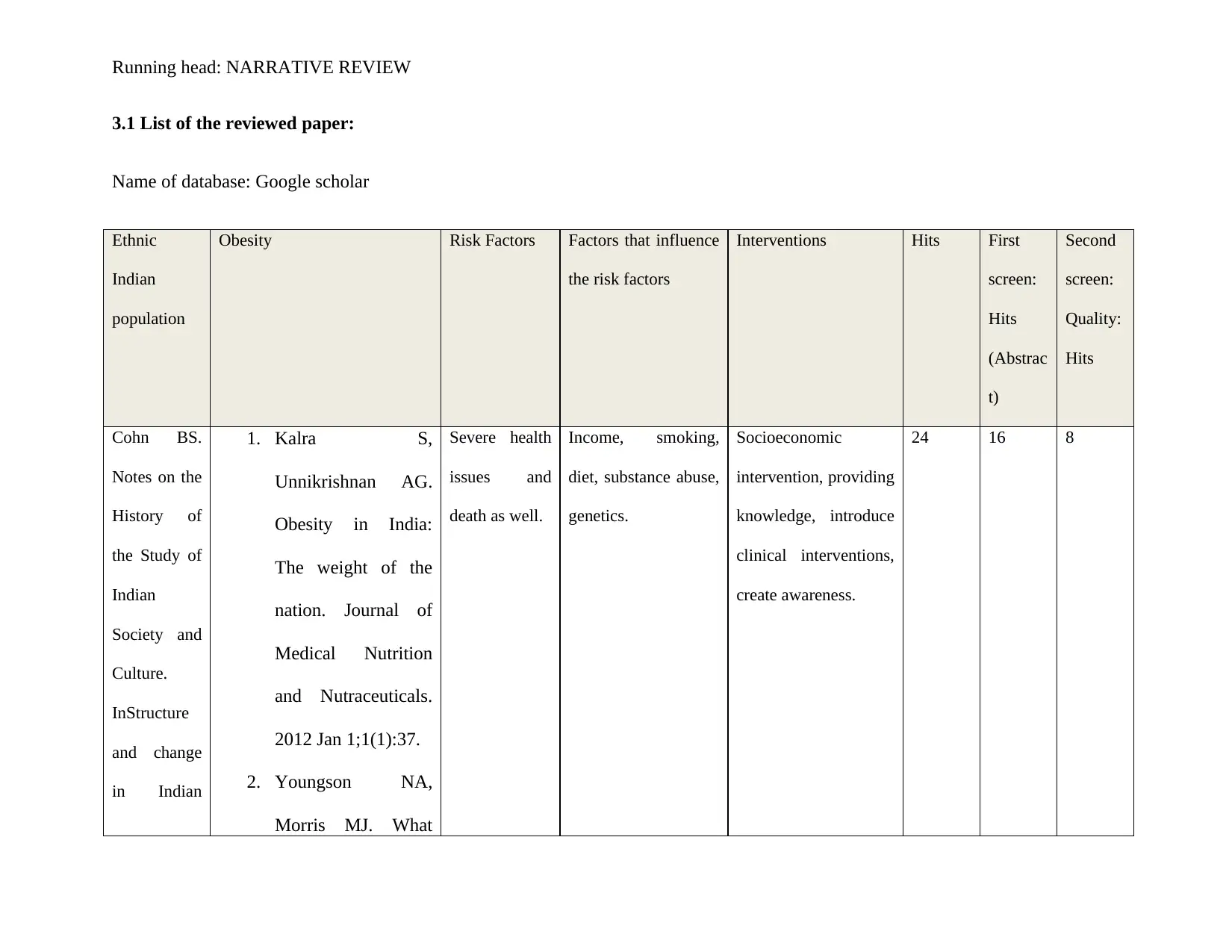
Running head: NARRATIVE REVIEW
3.1 List of the reviewed paper:
Name of database: Google scholar
Ethnic
Indian
population
Obesity Risk Factors Factors that influence
the risk factors
Interventions Hits First
screen:
Hits
(Abstrac
t)
Second
screen:
Quality:
Hits
Cohn BS.
Notes on the
History of
the Study of
Indian
Society and
Culture.
InStructure
and change
in Indian
1. Kalra S,
Unnikrishnan AG.
Obesity in India:
The weight of the
nation. Journal of
Medical Nutrition
and Nutraceuticals.
2012 Jan 1;1(1):37.
2. Youngson NA,
Morris MJ. What
Severe health
issues and
death as well.
Income, smoking,
diet, substance abuse,
genetics.
Socioeconomic
intervention, providing
knowledge, introduce
clinical interventions,
create awareness.
24 16 8
3.1 List of the reviewed paper:
Name of database: Google scholar
Ethnic
Indian
population
Obesity Risk Factors Factors that influence
the risk factors
Interventions Hits First
screen:
Hits
(Abstrac
t)
Second
screen:
Quality:
Hits
Cohn BS.
Notes on the
History of
the Study of
Indian
Society and
Culture.
InStructure
and change
in Indian
1. Kalra S,
Unnikrishnan AG.
Obesity in India:
The weight of the
nation. Journal of
Medical Nutrition
and Nutraceuticals.
2012 Jan 1;1(1):37.
2. Youngson NA,
Morris MJ. What
Severe health
issues and
death as well.
Income, smoking,
diet, substance abuse,
genetics.
Socioeconomic
intervention, providing
knowledge, introduce
clinical interventions,
create awareness.
24 16 8
Paraphrase This Document
Need a fresh take? Get an instant paraphrase of this document with our AI Paraphraser
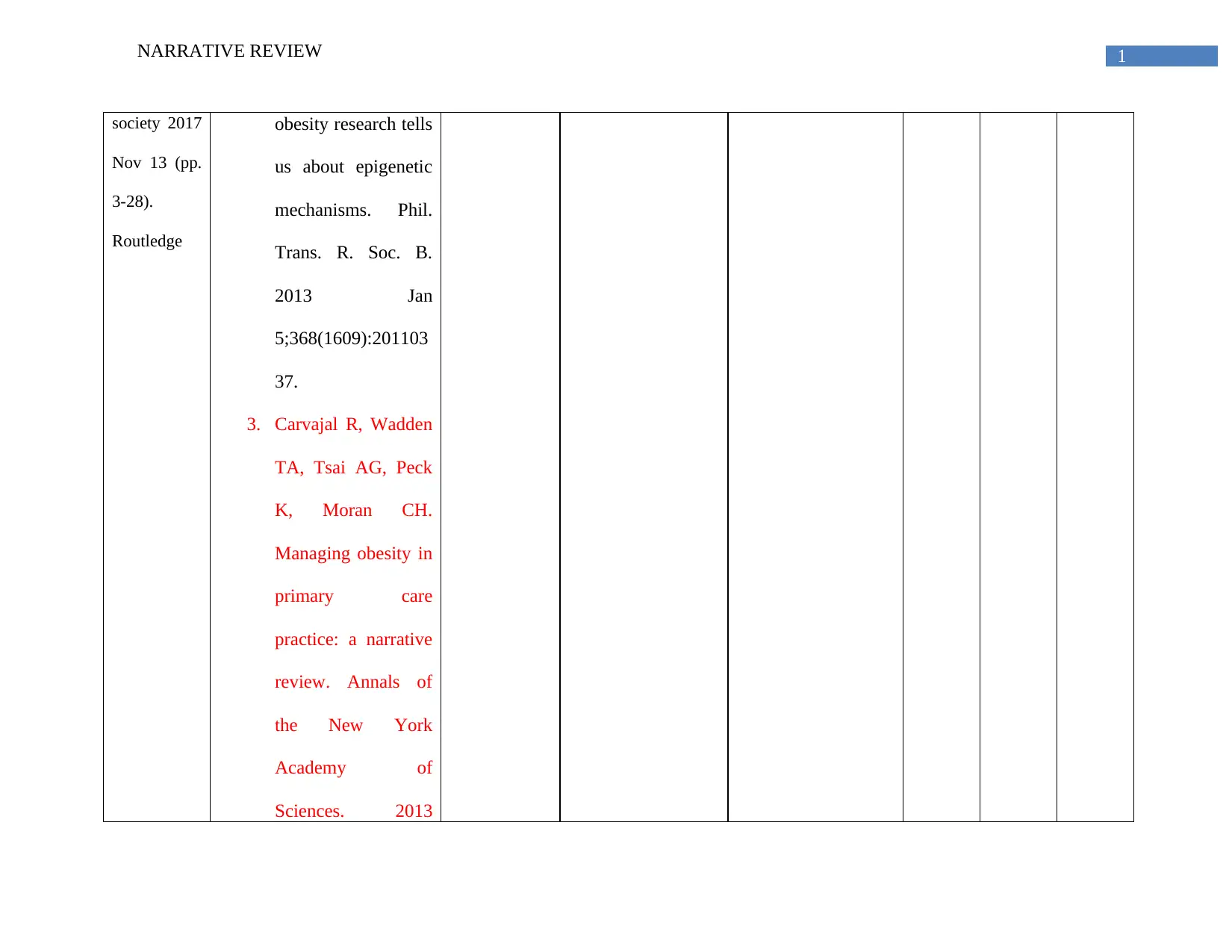
1NARRATIVE REVIEW
society 2017
Nov 13 (pp.
3-28).
Routledge
obesity research tells
us about epigenetic
mechanisms. Phil.
Trans. R. Soc. B.
2013 Jan
5;368(1609):201103
37.
3. Carvajal R, Wadden
TA, Tsai AG, Peck
K, Moran CH.
Managing obesity in
primary care
practice: a narrative
review. Annals of
the New York
Academy of
Sciences. 2013
society 2017
Nov 13 (pp.
3-28).
Routledge
obesity research tells
us about epigenetic
mechanisms. Phil.
Trans. R. Soc. B.
2013 Jan
5;368(1609):201103
37.
3. Carvajal R, Wadden
TA, Tsai AG, Peck
K, Moran CH.
Managing obesity in
primary care
practice: a narrative
review. Annals of
the New York
Academy of
Sciences. 2013

2NARRATIVE REVIEW
Apr;1281(1):191-
206.
4. Wright J, Harwood
V, editors.
Biopolitics and
the'obesity
epidemic': governing
bodies. Routledge;
2012 Mar 22.
5. Wright J. Biopower,
biopedagogies and
the obesity
epidemic.
InBiopolitics and
the'Obesity
Epidemic' 2012 Mar
22 (pp. 9-22).
Apr;1281(1):191-
206.
4. Wright J, Harwood
V, editors.
Biopolitics and
the'obesity
epidemic': governing
bodies. Routledge;
2012 Mar 22.
5. Wright J. Biopower,
biopedagogies and
the obesity
epidemic.
InBiopolitics and
the'Obesity
Epidemic' 2012 Mar
22 (pp. 9-22).
⊘ This is a preview!⊘
Do you want full access?
Subscribe today to unlock all pages.

Trusted by 1+ million students worldwide

3NARRATIVE REVIEW
Routledge.
6. Abarca-Gómez L,
Abdeen ZA, Hamid
ZA, Abu-Rmeileh
NM, Acosta-Cazares
B, Acuin C, Adams
RJ, Aekplakorn W,
Afsana K, Aguilar-
Salinas CA,
Agyemang C.
Worldwide trends in
body-mass index,
underweight,
overweight, and
obesity from 1975 to
2016: a pooled
analysis of 2416
Routledge.
6. Abarca-Gómez L,
Abdeen ZA, Hamid
ZA, Abu-Rmeileh
NM, Acosta-Cazares
B, Acuin C, Adams
RJ, Aekplakorn W,
Afsana K, Aguilar-
Salinas CA,
Agyemang C.
Worldwide trends in
body-mass index,
underweight,
overweight, and
obesity from 1975 to
2016: a pooled
analysis of 2416
Paraphrase This Document
Need a fresh take? Get an instant paraphrase of this document with our AI Paraphraser

4NARRATIVE REVIEW
population-based
measurement studies
in 128· 9 million
children,
adolescents, and
adults. The Lancet.
2017 Dec
16;390(10113):2627
-42.
7. Pischon T, Nimptsch
K, editors. Obesity
and Cancer.
Springer; 2016 Dec
1.
population-based
measurement studies
in 128· 9 million
children,
adolescents, and
adults. The Lancet.
2017 Dec
16;390(10113):2627
-42.
7. Pischon T, Nimptsch
K, editors. Obesity
and Cancer.
Springer; 2016 Dec
1.

5NARRATIVE REVIEW
Other search
terms which
relate to
your
population
Other search terms You might
want to list
certain ones?
Other factors Public health initiative
etc,
Indian,
Ethnicity in
India, Indian
demography.
Overweight, prevalence of
obesity, intervention of
obesity, risk factors of obesity,
genetics and obesity.
Diabetes,
cardiovascular
risk,
respiratory
disorder,
cancer
Poverty, education,
lack of nutrition.
Healthy diet, physical
activity, change
lifestyle.
Name of database: PubMed
Ethnic
Indian
Obesity Risk Factors Factors that influence
the risk factors
Interventions Hits First
screen:
Second
screen:
Other search
terms which
relate to
your
population
Other search terms You might
want to list
certain ones?
Other factors Public health initiative
etc,
Indian,
Ethnicity in
India, Indian
demography.
Overweight, prevalence of
obesity, intervention of
obesity, risk factors of obesity,
genetics and obesity.
Diabetes,
cardiovascular
risk,
respiratory
disorder,
cancer
Poverty, education,
lack of nutrition.
Healthy diet, physical
activity, change
lifestyle.
Name of database: PubMed
Ethnic
Indian
Obesity Risk Factors Factors that influence
the risk factors
Interventions Hits First
screen:
Second
screen:
⊘ This is a preview!⊘
Do you want full access?
Subscribe today to unlock all pages.

Trusted by 1+ million students worldwide
1 out of 31
Related Documents
Your All-in-One AI-Powered Toolkit for Academic Success.
+13062052269
info@desklib.com
Available 24*7 on WhatsApp / Email
![[object Object]](/_next/static/media/star-bottom.7253800d.svg)
Unlock your academic potential
Copyright © 2020–2025 A2Z Services. All Rights Reserved. Developed and managed by ZUCOL.





